| This post may contain affiliate links. If you click on the links and buy, we get a commission. It doesn't cost you anything. See the full disclaimer here. |
Everything you need to know about djembe reskinning is detailed here, with photos, diagrams and links to the tools you will need.
Djembe skins can break during playing, while tuning the drum or all by themselves in the middle of the night with a loud crack.
Horrible as any of these sound, re-skinning is a task I believe every serious djembe player should go through at least once.
I say 'go through' because it's hard work and is not a job you want to be doing an hour before a jam session.

If you don't have some sort of tensioning device, there's some strenuous pulling on the ropes to do. Then there's all that weaving to thread, which can take its toll on your hands. The job might be easier with someone to help.
If you have any back problems, or don't feel up to the physical task, ask a burly friend or relative to chip in.
Sira kelen sira te - "One way is no way at all" - Malinke saying.
Do it your own way. If you find a better method, please share!
1. The components of a djembe
A standard hand-made djembe is made up of 4 parts:
- A wood shell
- Three metal rings (2 large, 1 small)
- Three lengths of rope
- A drum skin
The metal rings grip the skin in place over the top of the wooden shell. The rope is used to tighten the skin and make the drum playable.

Like so:

The Rings
Ring 1: Large metal ring at the top with rope loops (red)
Ring 2: Large metal ring just below this with no rope loops (blue)
Ring 3: Small metal ring around the center of the drum with rope loops (small red)
The Rope
3 lengths of rope are used (we'll discuss rope more later).
Rope 1: Used to make the loops around Ring 1.
Rope 2: Used to make the loops around Ring 3.
Rope 3: Used to thread between Ring 1 and Ring 3.
The rope on the metal rings is a simple weave of one piece of rope all the way around.
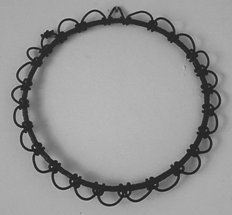
The verticals are used to pull the top ring towards the bottom ring, stretching the skin and tightening the drum.
We will talk about creating the loops and verticals in detail later.
The Skin
Animal skin is used, most commonly goat. Cow skin and antelope can also be used, as well as synthetic skins. If you are replacing a broken skin, there are several available. Check the skin against the light for imperfections. A good skin should not shed hair excessively. Choose thicker skins (>1mm) for large drums over 35cm diameter. Thinner skins (less than 1mm) are best for higher-pitched or smaller rims of 30cms or less. Thinner skins seem to be easier for small hands and beginners or intermediate drummers. Thicker skins are more difficult to play and would suit more advanced players.
The Wood Shell
The shell is usually carved from one piece of wood. They range in size depending on preference and several types of wood are used.
2. Timeline of the job
Djembe reskinning should really be done over two or even three days to allow the skin time to set before tightening fully.
On your first try, allow about 3 hours, to fit, string and tighten the skin and another hour the on following day to retighten. It is best done outside, or on a washable floor.
(Optional) To oil the drum you will need to add a day or two in between dismantling and re-skinning it for the wood to dry.
Once assembled, the skin will take a few days to dry.
Two days before: (Optional) Oiling the wood
Day 1:
- Preparing The Skin (30-120 mins soaking time)
- Dismantling the Jembe (20 mins)
- Filing The Shell (Optional)
- Repairing Cracks (Optional)
- Oiling The Shell (Optional)
- Cloth Wrapping The Rings (Optional)
- Making Hoops On The Rings (Optional)
- Assembling the Jembe (30 minutes)
- Tensioning The Verticals (45 minutes)
Day 2:
- Tensioning The Verticals (30 minutes)
- The Mali Weave (30 minutes)
3. Tools
For reskinning a large djembe you will need the above items, plus:
- Large bucket
- String
- Matches or lighter
- Sharp knife
- Scissors
- Pliers
- Hammer
- A short thick stick, about 14" long (a short section of a broom stick is ideal)
- Felt-tip pen
- Heavy, medium and light sandpaper (optional)
- Rubber tennis racket grip - approx 3m/ 10" (optional)
- Clamcleat puller (optional)
- Djembe Drum Rope Puller Bar Tool (optional)
- Rasp/File (Optional)
- Linseed Oil or Shea Butter (Optional)
- Ordinary candle wax (Optional)
- Razor blade (only required if the skin has hair)
4. Rope
If your rope is frayed or has snapped in places, it's best to replace it.
Djembes use a few different types of rope, but most is a type of braided cord. There are plenty of colors and patterns to choose from.
BRAIDED CORD
Braided cord is made by braiding several fibres together to create a larger stronger rope. The sometimes, but not always, have another rope inside an outer sleeve, to further strengthen the rope.
Materials used are mostly pre-stretched nylon, polyester or polypropylene.
Diameters for solid core/internal braid cord, are 4-6mm/ 3/16" diameter.
A lot of African djembes also come with 3mm flat rope. This is rope that has no internal braid.
BREAKING STRAIN
For a full size djembe, the breaking strength should be at least 800 lbs. If you are pulling a large djembe very tight, you will need more, around 1000lbs to be sure.
LENGTH
If you are replacing all the rope on your djembe, you’ll need about 80 ft or 25 metres for a large djembe.
If you’re just replacing just the verticals, you need 66 foot or 20 metres. And if you’re just replacing the loops, you need 16 foot that’s 5 metres.
If you're upgrading your rope, try to find either of:
1. 5mm or 6mm Nylon braided cord, with an inner core.
2. 5mm or 6mm Polypropylene of polyester braided cord, with an inner core.
Budget options:
3. 550 Paracord Type III (3.8mm diameter) - for smaller drums (<10")
4. 750 Paracord Type IV (4.2mm diameter) - for larger drums (>10")
5. Links to Buy Tools
Here's a selection of the best djembe ropes on Amazon for various budgets and color choices.
New Rope
New drum skin
You can choose to either have skin with hair, or skin without. If you are doing this for the first time, I would recommend skin without hair. It will save you time and effort when reskinning, but you will not have the option to have a fur collar around your drum.
Here are a few of the best djembe skins on Amazon.
Hairless (for beginners I would recommend the one on the left):
With hair:
Clamcleat puller
This small device is for gripping the rope and allowing you to pull on it without giving you blisters on your hands! Well worth it.
Djembe Drum Rope Puller Bar Tool
This is a device for pulling the ropes to tighten the drum. It replaces the short stick above. This one is quite expensive, but if you're going to be reskinning more than one drum in your life, it's a great investment.
Rubber tennis racket grip - approx 3m/ 10" (optional)
This is used for adding grip to the rings, so that the rope does not slip.
You could also use a 3m strip of cotton cloth about 5cm wide.
Linseed oil or shea butter (optional)
Some people suggest shea butter, altough I would go for linseed oil,but avoid boiled linseed oil. This is the good stuff. This product is actually for cricket bats, but will do fine on a drum.
Razor blades
These are the ones:
6. Preparation
Preparing The Skin - do this ideally 2 hours before you start

Bend and fold the skin carefully so you can fit it into a bucket of tap water, making sure to submerge the whole skin without cracking or creasing the playing area. Soak the skin for 2 hours if possible. The longer it soaks, the more pliable it becomes and the easier it is to remove the hairs. Some people leave it for as long as 2 days although longer than this is probably unnecessary. It kinda starts to stink too!
Dismantling the Jembe
If the old broken skin is damaged, simply cut or tear it off. Use a hammer to tap the rings loose if necessary. Once the rings are loose the vertical binding should be easy to undo. Undamaged skin can be used for another drum, in which case you will need to undo the verticals without tearing the skin.
It's best to replace the rope every time you re-skin, but if you're going to re-use the old rope, check it carefully. Using rope that is frayed anywhere more than ¾ of the original width is risking a lot more work later.
Then check the rope loops on the metal rings for freying and the rings themselves for damage and have them repaired or replaced if necessary.
Any metal workshop should be able to cut, turn and weld a replacement steel rod for you.
Filing The Shell (Optional)
The outside edge of the top of the shell should be a nice smooth curved edge. If the edge is sharp or angular, playing can be painful on the hands. If necessary, use a rasp to file and then sandpaper to round a nice edge to save on bruises. Note that the inner edge shouldn't be rounded, concentrate on the outer edge and sand off any sharp points.
Repairing Cracks (Optional)
If your drum has any small cracks, use a coarse mixture of sawdust and wood glue to fill them. Larger cracks are bad news I'm afraid - almost irreparable in the long run. You could try wrapping some thick wire around the drum to stop the spread, but its not gonna be a great drum or very pretty.
Oiling The Shell (Optional)
This may take an extra days or two, but oiling the wood will help to keep it hydrated and beautiful.
To oil your drum, simply brush the entire shell with the raw linseed oil. Come to think of it, the smell of linseed oil on wood reminds me of every African curio shop I've ever been in to.
It is fairly easy to work with but avoid contact with the skin and eyes. Use an old paintbrush to apply and leave for a couple of days for the oil to be fully absorbed. Until then, your re-skinning will be on hold.
7. Making loops in the metal rings
Note: This only needs to be done if the existing rope on the rings is old or has frayed. If your rope is fine move on to 6. Making the drum head.
Undo the existing rope and any cloth or grip that has been used underneath it. These strips of cloth allow the rope better grip on the ring. Replace this using the rubber grip or long strip of cloth.
Wind the cloth or rubber around the ring and tie off or tuck away any loose end.
The loops in the rings
The rope loops are a series of cow hitches (knots), detailed below. The top ring should eventually look like this:
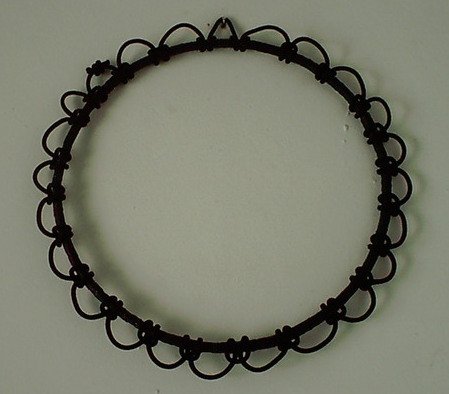
The loops in the bottom ring need to be done with the metal ring still around the waist (it usually isn't meant to come off, but some do) , which makes it a bit more tricky.

How to make the loops on the large (top) ring
Step 1: Starting at one end of the rope, thread it around the ring as shown.

Step 2: Thread another loop as shown.

Step 3: Tighten the knot and repeat the process, slowly working your way around the ring.

Important! Make the same number of loops in the top and bottom rings, and stick within the 22-30 limits on regular sized drums.
When you reach the other end of the rope, tie the two ends to each other in a reef knot/square knot, shown here.

It should now look like this:

How to make the loops on the small (bottom) ring
The loops in the small ring are a mirror image of the loops in the top ring. The process is the same, but we provided illustrations below to help.
IMPORTANT: Remember to make the same number of loops in the top and bottom rings, and stick within the 22-30 limits on regular sized drums.
Step 1: Remove the old rope completely. Starting at one end of the rope, thread it around the ring as shown.
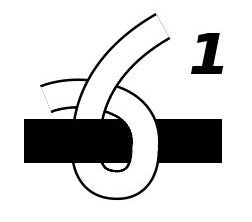
Step 2: Thread another loop as shown.

Step 3: Tighten the knot and repeat the process, slowly working your way around the ring.
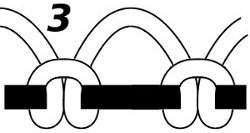
When you reach the other end of the rope, tie the two ends to each other using the reef knot.

8. Making the drum head
Stretching And Cleaning The Skin
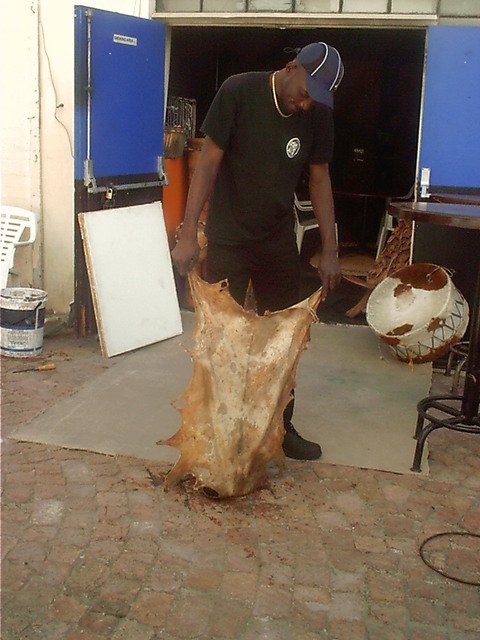
This is the dirty bit so dress down and do this outside!
Remove the skin from water and examine the slimy side for any loose skin or fat and remove with a knife.
Stretch it slightly by standing on one end and pulling the other as shown. Try to stretch all sides evenly.
Now take the large metal ring without loops and tie a small piece of string on at one place as a marker (this will come in handy later).
Making The Drum Head

1. Lay the skin hair-side up on a table or clean flat surface and place the large unbraided ring in the centre. Align the ring so that the spine (darker, denser hair) runs down the centre and the string marker is at the top.
Remove excess skin, leaving a border around the ring of at least 15cm on all sides.
2. Fold the edges over into the centre of the ring, creating something that looks a bit like a dim sum. Mmm. The is the first part of the drumhead.

3. Make about 10 or 15 incisions in the excess skin that has been folded up along the outer edge. Thread some string between the holes and lace the drum head until your drum head looks like this:
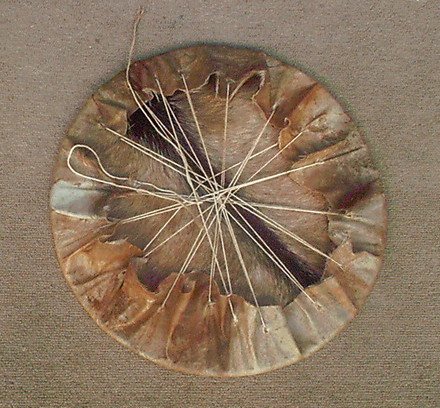
4. Place the drumhead on the rim of the shell, aligning the string with the mark you made on the wood. Check that the drumhead is centred on the rim and place the braided ring on top.
Aligning The Rings
As neither the jembe nor the rings may be exactly round, hold the ring in place over the jembe and rotate them if necessary to find the best fit. Position them centred on the rim, with an equal distance between the drum and the ring all the way around. Bend them if necessary to make a good fit.
Now take the other large ring (with the loops on it) and lay it over the drum head, aligning it carefully so the rings line up with each other and both are centred over the drum shell.

From the top:
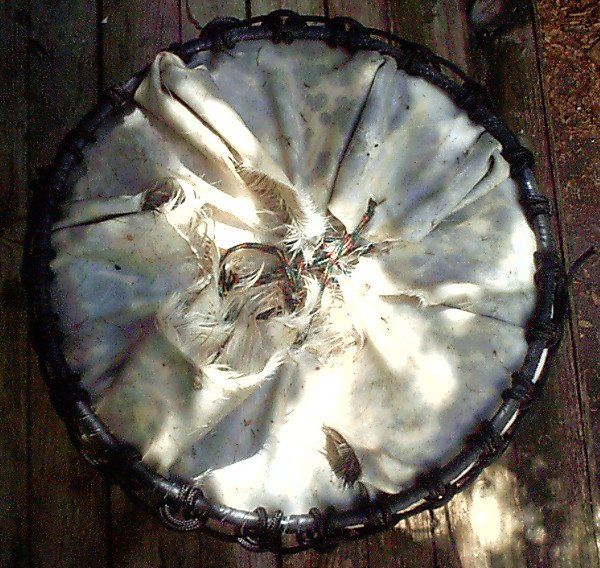
9. Threading the verticals
A length of rope is used to thread loosely between the top loops and the bottom loops, all the way around the drum, creating what are called verticals.

Here's how:
1. Thread the rope between the fist two loops as shown.

2. Take the left hand piece and make a bowline noose as follows.
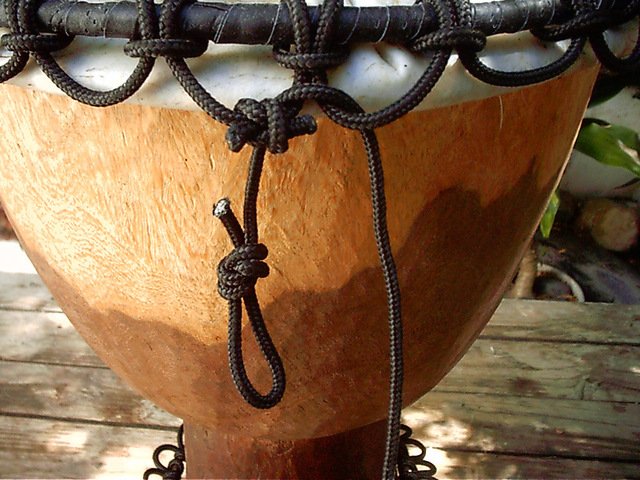
3. Take the right hand piece and thread through a loop in the bottom ring and up through the next one.

4. Thread back up through the top ring again - up through the same loop as you came and down the next.
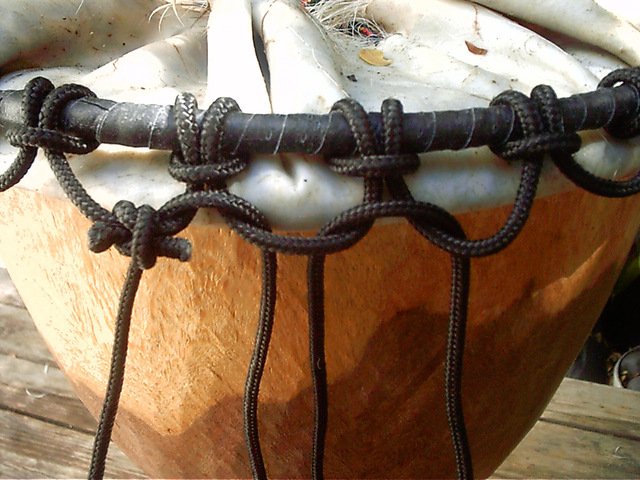
Continue this way and thread the entire drum without putting any tension on the skin. If you don't get all the way around, don't worry.

6. Starting at your original knot, gently tighten the rope by working your way around the verticals taking up a little bit of slack on each. When you reach the other end of the rope, tie it off and start again.
Do this at least a couple of times, getting progressively tighter each round. Be careful not to pull the rings out of alignment or you may end up with a skew drum head.
You don't have to make it incredibly tight, just enough to hold the rings in place for the next step.
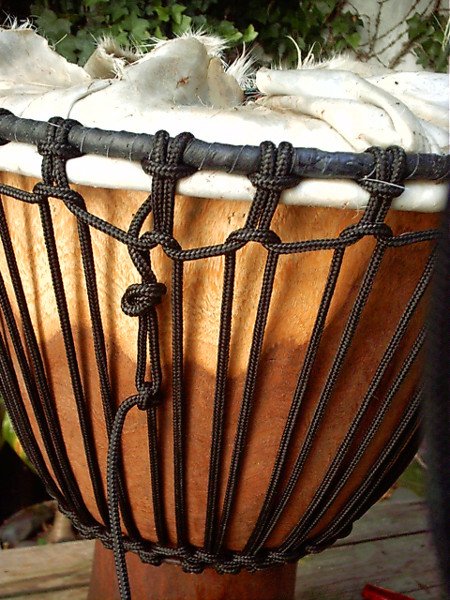
7. Turn the drum upside down, resting it on a covered surface.
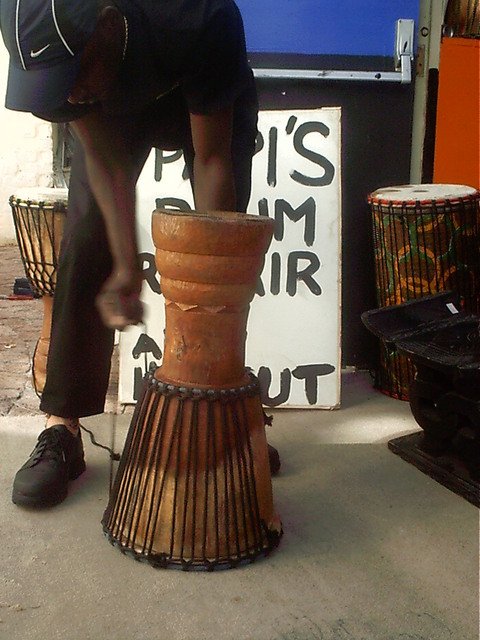
Starting where your noose is, work your way around the drum again pulling tighter on each vertical to take up more slack. Putting the drum upside down will help you get more leverage, as this needs to be quite tight.
When the verticals have been threaded all the way around the drum and sufficiently tightened.
When you get back to the beginning, tie off on the noose.
The more you can do this while the skin is still wet, the better. At some point, cut the string on the 'dim sum' we made earlier - the string that holds the loose edges of skin together on the face of the drum. This might help to allow you to tighten the skin further.
When you're tightening, remember to keep the drum upside down or the rings may go out of alignment.
Finally, when you've had enough of that, tie off the rope and turn the djembe the right way up again.
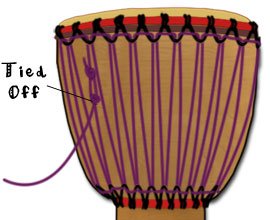
You're done with threading the verticals! There is more tightening to be done later, but we'll get there.
10. Trimming the skin
When your drum is the right way up, fold the excess skin back over the sides. Finally it's starting to look like a drum!
Trimming The Edge
There are two options to choose from when deciding what to do with the excess skin. You can allow the excess skin to flop over the sides and create a collar covering the rings and the top section of the rope loops, or you can cut it close to the rings and have no collar.
Option 1: Collar
The excess skin can be folded out over the rings and trimmed just below the top of the rope loops, before being allowed to dry. Use a length of rope or string to hold the skin down over the rings and cut the excess skin off below the rope.
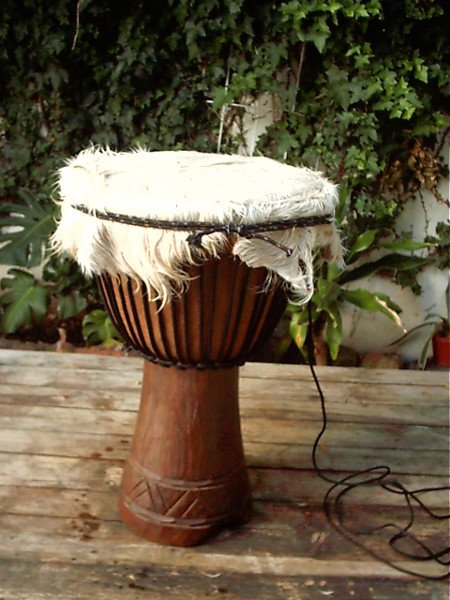
Option 2: No collar
If you would prefer a clean cut look, i.e. not much hair or fur on the edge of the drum, cut the excess skin off with a pair of scissors as shown below. Cut quite close to the rings so as to leave the rings visible, but not too close so the skin slips out. You should have about half and inch of skin sticking out (1 or 2cm), and it should be short enough not to stick out and interfere with your playing of the drum.

11. Removing The hair from the drum head (only for skins with fur)
For the drum head to resonate well, you need to remove as much of the fur as possible. I met a guy who used his wife's hair dilapidating cream to do this! I haven't tried myself but he said it was simple and worked well. Here's the traditional method though:
The most common is to shave the hair on the drum face with a razor blade. This can be slow and can leave your drum skin with a few nasty nicks if you're not extremely careful. It is also easier if the drum is tight and the skin is dry.
1. Hold the razorblade between your thumb and forefingers and use a little bit of pressure to bend it slightly.
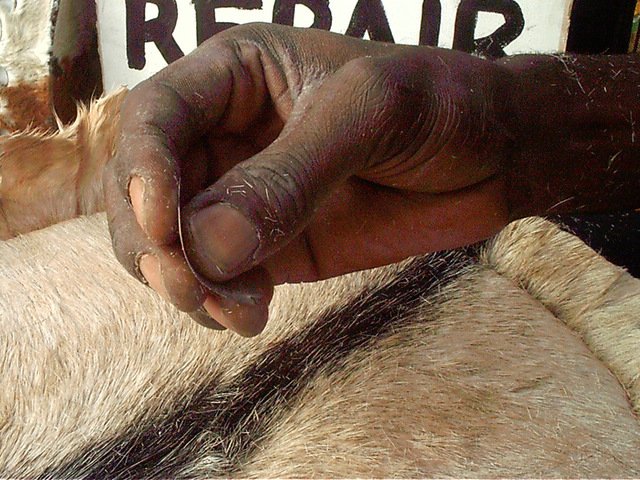
2. Hold the razor blade at a 90 degree angle to the skin and shave with the grain of the hair.

Be careful! When you're mostly done use a light, smooth sandpaper to remove the last stubble and dirt from the skin. Work carefully and lightly to remove all hair on the face of the drum and lightly sand a border around the rim, until the whole face and edges are smooth and clean. Take your time to remove all dirt and hair without scratching the skin. Be careful to sand lightly.
Booya, the first part is done!
There's still the tough job of djembe tuning to do, so when you're ready, continue to Djembe Tuning.



















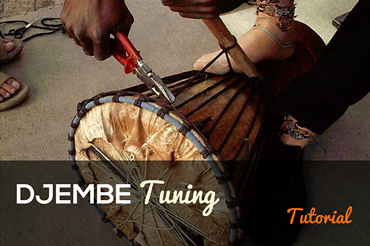
Thank you
Superb and extremely well done. Many, many thanks!
Im stuck here please cause its not clear-as I have a hairless skin soaking, and do I need to step on it to STRETCH IT BEFORE PUTTING IT ON THE RING? (just like he did above with the haired one?) Also where am I to make a mark on the drum? skins been soaking about 4 hours now! maybe ill take it out and wait idk please help!
Hi,
Yes you can stretch a hairless skin too – either with hair or not is fine to stretch. You can make the mark on the drum anywhere you like really, it just has to line up with the mark that you make on the ring. This is only necessary if the drum is not perfectly round, as the ring won’t be perfectly round either, so you’re trying to line them up nicely so the ring will fit snugly on the drum.
Hope that helps!
Al
I just finished my first re-skinning! I was given a djembe with a torn skin because they didn’t want get it fixed or do it themselves. I got a goatskin with hair, and set out. I am happy with the results. I made some rookie mistake and it probably won’t last as long as it should, but it sounds great! I have a couple questions, but first what I learned…
First, when I folded the skin over the ring, I probably folded it too tight. Once I untied it and folded it over the outer ring, I could see it was off-center. My first folds probably moved the ring and I didn’t check it carefully before tying it up. If I had, I probably could have re-centered it without too much trouble. I don’t know how this will effect the sound or life to the skin. It is about 2 cm off center.
Second, I trimmed too much off from around the edges. I wanted a collar, but in several parts, I didn’t leave enough skin to cover the top knots. In one spot the outer ring is visible. I really like the look of the collar covering the knots and how it shrinks to be pressed against the verticals. After putting the skin on and tying loose verticals, I trimmed it to cover the top portion of the knots and left the hair on. It looks okay, but not how I really wanted it. I tied the collar differently because it was so short. I crisscrossed back and forth over the head in a star pattern. Wrapping the rope around the head, it would slip down before reaching collar due to the taper of the body. I made sure the the collar was flat under the star pattern. After sitting overnight, I took that off. I could feel it was starting to firm up. I wrapped around the edge again, except the first wrap, I put as close the edge of the skin as possible and knot it to the vertical. So the first wrap kind of followed the edge of the collar. I used these knots to prevent the rope from slipping on the following wraps . I didn’t need as many wraps to close the gap to the shortest parts of the collar.
Third, I got a little impatient removing the hair. I used a stiff, single edge blade in a handle instead of a loose double edge blade. It was efficient at removing the hair, but I did nick it a few times. I also tried to go over the corner at the edge using the razor and nicked it there too. When I got to sanding it, I found the sand paper did a good job removing the hair and I probably didn’t need to take off as much as I did with the razor. And I should have used only the sandpaper on the sides. Fortunately, the nicks did not cut all the way through and I was able to mostly sand them out. I could get them all out and the skin it thinner in those spots, I’m sure it will wear and age more quickly. But now I know for next time.
Now my questions. 1) How smooth should the skin be? As I sand it, it feels very smooth. But after I wipe the dust off, I can feel stubble, particularly going against the grain. If I wipe against the grain with a paper towel, it will leave some shreds behind. So far it doesn’t really bother me when I’m playing.
2) How straight should the rings be? I can see they are a little lower on one side. I have not done the Mali weave yet and I can probably adjust the tension to straighten the rings. Is that really necessary? The difference between the lowest and highest points is probably less than a cm or two. Can I use the weave to balance it?
3) How tight should I make the verticals before doing the weave? Is it okay to skip the weave? It has nice ring to it, and I have to push pretty hard to deflect the skin at the center of the head. How much, if at all, should I be able to deflect it?
On to the next step: learning how to play it!
Cheers!
Hi,
That’s a good tip to get a cheap djembe – a lot of people have broken djembes lying around gathering dust.
Re your points:
1. If the skin is off center, it shouldn’t affect the sound, it’s more of a visual thing. You could maybe try and pull it a bit more to the center before you tighten the rings too much if it bugs you.
2. i agree, I prefer the look of the skin over the rings but it can be tricky to cut it right. Your weaving sounds interesting, but I’m not sure if I understood it completely.
3. A few nicks on the skin are ok as I said, and yes, the shaving is a long and boring task. You’re probably right about the sandpaper, it might be quicker to go straight to that. I’ve just seen the pros do it with a razor in no time at all.
Your questions:
1. I don’t think the skin needs to be too smooth. It will wear over time as you play it. That stubble will stay there for a while until it has been played in. The vibrations will also help to loosen the stubble, and it will eventually come off. If the stubble is say, more that ‘a few days growth’, I would work to reduce it s bit more. That’s where the razor is better – it takes the hair off completely.
2. The rings may be off slightly, it happens and there’s not much you can do about it. Once the skin has dried there is no way to straighten them unless you take the whole skin off. Less that a cm or two is not bad, I would live with that. The weave won’t really balance it, but if the skin is still wet you may be able to use a mallet and block of rubber (or something that won’t tear the skin) to tap the higher side down a bit).
3. How tight to make the verticals before doing the weave? I would say if you can pull the vertical more than 5 or 6 inches from the body (using a stick) then you should go around again and tighten. If it’s less that than, you’re probably ready to start the weave. Good question!
Hope that all helps,
Regards
Al
AI – Thank you for your response. It is very helpful. I let this slip off my screen, trying to finish a long term project, building a guitar.
To clarify how I tied down the collar…
The star pattern: I tied the end of a parachord to a verticle just under the ring. Then I ran it over the head, to a verticle directly across, so it crosses over the head near the center. Then I went around head 2-3 verticals and tied it again. Then back over the head crossing at center again. Now it looks like a (round) pizza after the 1st two cuts. More over another 2-3 verts, knot, cross over center of the head, repeat. When it’s finished it looks like a (still round) that’s been cut into thin slices.
The wrapping: I tried a parachord to a verticle, just under the edge of the collar at the point where it is widest/lowest. Then I went around the drum 5-6 verticles and tied another knot. I continued, knotting every 5-6 verts, until I’d gone around the drum once. I start the next wrap above that 1st wrap. Because the body of the drum narrows as we go down, the wraps will tend to slip down. The knots in the 1st wrap will prevent subsequent wraps slipping down. From this point, I continue wrapping, sprialing up towards the top of the drum. When the sides of the collar are covered, I end the wrapping by tying to the previous wrap.
Pictures would help, but I didn’t take any at the time. I’ll re-do it and add pictures in another message.